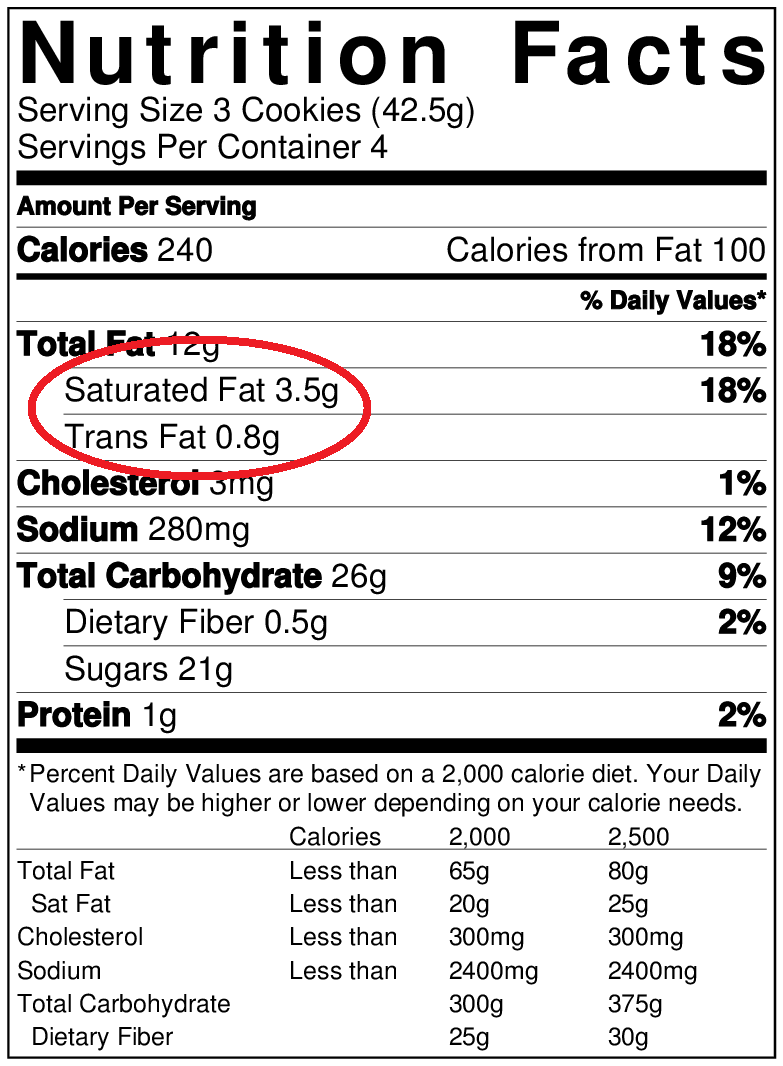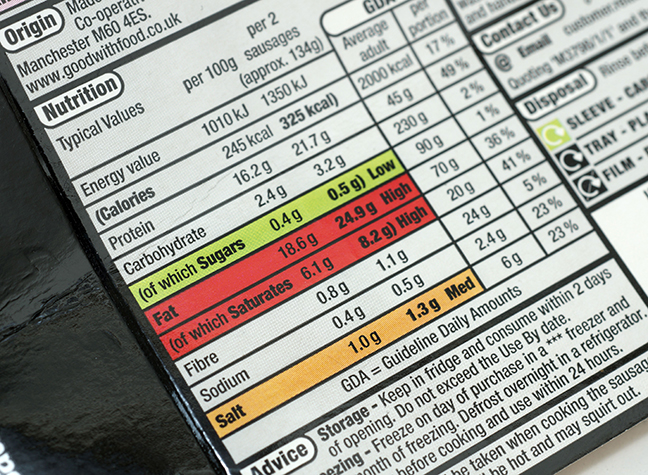45 how to read trans fats on food labels
Food Label Ingredients: How to Look for MSG, Trans Fat ... Foods can call themselves "trans-fat free" even if they contain up to half a gram of trans fats per serving. Look on the ingredients list. If a food contains partially hydrogenated oils, it... Food Labels: How to Read Them | Tips from a Registered ... A quick way to gauge if a food is high in saturated fat is to just look at the %DV. Ingredient list For trans-fats, it is important to look not only at the nutrition facts label, but also the ingredient list. Manufacturers can list "0 grams" for trans-fat on the label if there are 0.49 grams or less per serving.
Interpreting Total Fat and Types of Fat on Food Labels ... Determining the type of fat can help you decide whether or not a food is rich in 'healthy' and/or 'unhealthy' fats. Trans fats and, in some cases saturated fats, are considered "unhealthy" or "bad" while monounsaturated and polyunsaturated (omega-3) fats are generally healthier alternatives or "good" fats.
How to read trans fats on food labels
How to Read a Food Label - Well Guides - The New York Times A label might say "0 grams trans fat" on the front but be quite high in saturated fat. Or a label might say "No added sugar" on the front but be quite high in sodium. You might not realize either... 3 Ways to Read Nutrition Facts on Food Labels - wikiHow Every number listed beneath "total fat" is calculated based on the amount contained in a single serving. So if the saturated fat on a label is listed at 6 grams but the number of servings is listed as 3, it means that there are a total of 18 grams of saturated fat in the container. [1] PDF How Do I Understand the "Nutrition Facts" Label? Nutrition Facts label and ingredient list. When you go grocery shopping, take time to read the Nutrition Facts labels on the foods you purchase. Compare the nutrients and calories in one food to those in another. The information may surprise you. Make sure you aren't buying foods high in calories, saturated fat, trans fat, sodium and added ...
How to read trans fats on food labels. Easy Way to Tell if Food Has Trans Fats; Don't Trust Labels Ignore the Front of the Package; Read the Ingredients List Often, the ingredients are in super tiny print. Use a magnifying glass if you must. Often, the ingredients list is lengthy. Take the time to read every word! If the ingredients list contains the following items, the food has trans fats: "Partially hydrogenated" or just "hydrogenated." PDF Food Label Tip: Choose Low Saturated Fat Trans Fat and ... trans fat, and cholesterol will raise your blood cholesterol level and increase your chances of developing heart disease. Compare food labels of similar products and choose the ones with the lowest % Daily Value* of saturated fat and cholesterol. In general, 5% or less is low. Twenty % or more is high. Also choose foods with no or low amounts of Reading food labels: Tips if you have diabetes - Mayo Clinic Nutrients and Daily Value: The label must list the amounts of total fat, saturated fat, trans fat, cholesterol, sodium, total carbohydrate, dietary fiber, sugars, protein, vitamin D, calcium, iron and potassium that are in one serving. The Daily Value (DV) tells you how close you are to meeting your daily requirements for each nutrient. How To Read Food and Beverage Labels | National Institute ... Avoid trans fats altogether — look for hydrogenated oil or partially hydrogenated oils in the ingredients list. Light, low-calorie, organic labeling — what do these mean? Sometimes, food and beverage packaging includes terms that may try to convince the consumer the food is healthy.
FDA Trans Fat Labeling: What You Need to Know - LabelCalc According to the FDA, trans fats should appear as "Trans fat" or "Trans" on the nutrition facts panel on a separate line located directly underneath "Saturated fat.". Values for trans fats must appear in grams per serving. If the value for your product is under 5 grams per serving, then you must round it to the nearest 0.5 gram. Food labeling: trans fatty acids in nutrition labeling ... The Food and Drug Administration (FDA) is amending its regulations on nutrition labeling to require that trans fatty acids be declared in the nutrition label of conventional foods and dietary supplements on a separate line immediately under the line for the declaration of saturated fatty acids. Trans Fat on Food Labels: Now You See It, Now You Don't That's because newly implemented U.S. Food and Drug Administration rules on labeling allow foods with less than 0.5 grams of trans fats per serving to claim "zero" grams of trans fats on their labels. Under these guidelines, which went into effect on Jan. 1, a food with 0.4 grams of trans fats can be listed as having zero trans fats. How to Understand and Use the Nutrition Facts Label | FDA It can tell you if a serving of food is high or low in a nutrient and whether a serving of the food contributes a lot, or a little, to your daily diet for each nutrient. Note: some nutrients on the...
Quick Tips for Reading the Nutrition Facts Label To create your Tip Card: 1. Use a pair of scissors to cut along the dotted lines. 2. Fold along the center line. 3. Keep the Tip Card in your wallet or purse. Calories230 Amount per serving Serving... Reading Food Labels | ADA - American Diabetes Association Put food labels to work. The Nutrition Facts labels on foods are really the key to making the best choices. We'll cover the basics so that these labels make shopping easier for you. You've heard it all. From carb-free to low-carb, to whole and empty carbs, it's hard to know what it all means. Interactive Nutrition Facts Label - Food and Drug ... Action Steps for Monitoring Trans Fat in Your Diet Download the Trans Fat Fact Sheet. (PDF: 157 KB) Nutrition Facts 4 servings per container Serving size 1 1/2 cup (208g) Amount Per Serving 240... Food Label Detective: How to Spot the Good Fats - The Dr ... On the Food Label . Both saturated fat and trans fat amounts are clearly listed underneath "Total Fat," although some foods labeled trans fat-free may still contain small amounts (up to 0.5 grams) of trans fat. That's why it's important to also check a food's ingredient list.
How to read and understand a nutrition label - CNET The bad fats are linked to bad cholesterol (or LDL) and heart disease, and the worst of these is trans fat -- it's so bad that the U.S. banned artificial trans fat from foods as of June 2018.
How To Understand Nutrition Labels - The Healthier Are you struggling to understand all those difficult terms on nutrition labels? Fear not because you are not alone. Saturated fat, trans fat, partially hydrogen
How To Read a Nutrition Label - Breaking Down the Sections ... Total Fat: An important consideration is the amount of saturated and trans fats as a high intake of these fats is associated with an increased risk for heart disease. Saturated fat: limit to less than 20 gm per day; Trans fat: aim for as little as possible; Cholesterol: Cholesterol is found in animal products such as meat, poultry, fish, dairy ...
Food Labels: Fat & Cholesterol | Home & Garden Information ... When comparing food labels, combine the grams (g) of saturated fat and trans fat, then choose the food with the lower combined amount. Look for the lowest % Daily Value for cholesterol, also. Ingredients List: When a food is made with more than one ingredient, an ingredients list is required on the label.
Reading Food Labels - Women's Heart Under Total Fat, find the grams of Saturated Fat.(The Grams of saturated fat are part of the total fat. Don't take in any trans-fat. You may not find trans-fat listed on food labels, so read the small print in the ingredients section and if the product contains partially hydrogenated oils, BOYCOTT that product!
Easy Guide to Understanding Food Labels When You Have High ... This means that your food may contain trans-fat even if the food label says 0 gram. Therefore it's important to check the ingredient list (more on this later). Cholesterol guidelines currently recommend having not more than 300 milligrams of cholesterol per day, and if you have heart disease, aim for less than 200 milligrams per day. 2.
How to read food labels: MedlinePlus Medical Encyclopedia Look for foods that have no trans fats or are low in them (1 gram or less). Sodium is the main ingredient of salt. This number is important for people who are trying to get less salt in their diet. If a label says that a food has 100 mg of sodium, this means it has about 250 mg of salt. You should eat no more than 2,300 mg of sodium per day.
How to Read a Nutrition Facts Label | Everyday Health For trans fats, nutrition labels are tricky. "The nutrition facts label can have 0 g listed next to trans fat, as long as the product has less than 0.5 g of trans fat per serving," says ...

.jpg)




Post a Comment for "45 how to read trans fats on food labels"